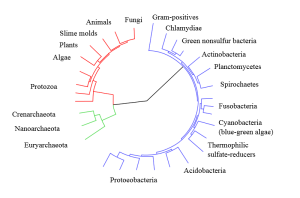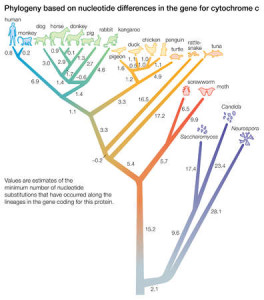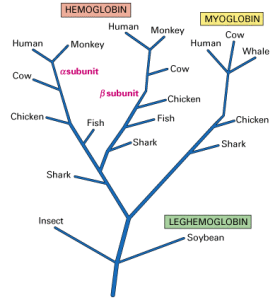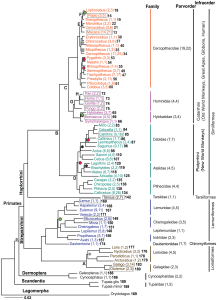Notes from our discussion, February 5 – from Rob Ross:
Molecular tree of life
Recent science has documented Darwin’s tree of life (Beasts, p. 59) in amazing detail. Here are four among the thousands of “tree of life” diagrams – created by scientists looking at differences in the amino acid sequence of proteins, or at differences in the nucleotide sequence of DNA.
 Tree of all life
Tree of all life
Click on the slide to enlarge it
The first illustration shows the tree for all living organisms, in circle form. The blue lines are the bacteria; the green lines are the “archaea”; and the red lines are the “eukaryotes”, those organisms whose cells have a nucleus. The archaea live in extreme environments, such as hot springs, and are still poorly understood. They resemble bacteria, and their very distinct genetic makeup was only discovered in the 1970s. This diagram shows that eukaryotes and archaea have a common ancestor. This divergence occurred approximately 2 billion years ago.
 Tree of life for animals and fungi
Tree of life for animals and fungi
Click on the slide to enlarge it
The second illustration is based on the DNA coding for cytochrome c, a protein found in all plants and animals, and also in many simpler organisms. The blue branch on the right shows the fungi. The divergence of fungi from plants and animals occurred approximately 1.6 billion years ago.
 Globin evolution
Globin evolution
Click on the slide to enlarge it
The third illustration is based on the DNA coding for globin proteins, which bind oxygen molecules. The hemoglobin molecules in blood each contain two subunits of alpha-globin and two subunits of beta-globin. Myoglobin binds oxygen in muscle tissue; it’s what makes red meat red. Leghemoglobin binds oxygen in the roots of legumes, where regulation of the amount of free oxygen is critical to nitrogen fixation. Because animals have three kinds of common globin proteins, some species are shown three times in the diagram. The divergence between hemoglobin and myoglobin occured approximately 1.1 billion years ago. The alpha and beta hemoglobins diverged approximately 500 million years ago.
 Primate connections and divergence
Primate connections and divergence
Click on the slide to enlarge it
This last illustration shows the primates, based on analysis of 54 genes and published in 2011. Green circles are used to mark where the branching detail is less than 70% certain. (Click on the slide to find the circles and other details.) The divergence between Homo (human) and Pan (chimpanzee), marked with an H, occurred 6-7 million years ago. The divergence of Pongo (orangutan) from the Homo-chimp-gorilla branch, marked with a G, occurred 13-18 million years ago.
Questions for Rob Ross or John Horsley?
Click on ‘Leave a Reply’ or ‘Replies’ (below).
